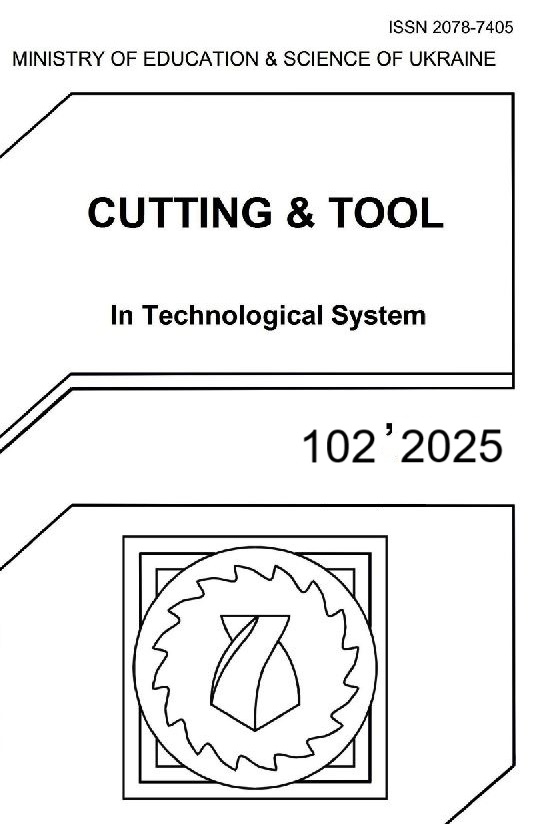CUTTING FORCE DISTRIBUTION IN TANGENTIAL TURNING OF 42CRMO4 ALLOY STEEL: INFLUENCE OF HIGH CUTTING SPEEDS AND HIGH FEED RATES
DOI:
https://doi.org/10.20998/2078-7405.2025.102.09Keywords:
design of experiments, cutting force, experiment, tangential turningAbstract
This study investigates the cutting force distribution during tangential turning of 42CrMo4 alloy steel under high cutting speeds and high feed rates. The experiments were conducted by varying cutting speed (200 and 250 m/min), feed rate (0.3 and 0.8 mm/rev), and depth of cut (0.1 and 0.2 mm). The major cutting force, feed directional force, and thrust force components were measured, and their maximum values and relative ratios were analysed. The results indicate that both cutting speed and feed rate have a significant influence on the magnitude and distribution of the cutting force components. Higher cutting speeds generally led to a reduction in cutting force values, while increased feed rates resulted in higher force magnitudes and altered force ratios. The obtained data contribute to a better understanding of the cutting mechanics in tangential turning, supporting process optimization and the selection of appropriate cutting parameters for improved machining performance.
References
Kumar, K., Zindani, D., & Davim, J. P. Advanced machining and manufacturing processes. In Materials forming, machining and tribology. (2018). https://doi.org/10.1007/978-3-319-76075-9
Huda, Z. Machining processes and machines. In CRC Press eBooks. (2020). https://doi.org/10.1201/9781003081203
Vasileva, D., Avramova, T., & Rusev, S. Comparative Analysis of Some Traditional Andandn-Traditional Cutting Schemes in the Turning Process. International Journal of Manufacturing Economics and Management, 4(2), 36–42. (2024). https://doi.org/10.54684/ijmem.2024.4.2.36
Schreiber, L., Trott, K. Verfahren zur Drallfreien Spanenden Bearbeitung von Rotationssymmetrischen Flächen. Patent DE19963897A1, 28 April 1999.
Rao, C., Rao, D. N., & Srihari, P. Influence of cutting parameters on cutting force and surface finish in turning operation. Procedia Engineering, 64, 1405–1415. (2013). https://doi.org/10.1016/j.proeng.2013.09.222
Klocke, F., & Kratz, H. Advanced tool edge geometry for high precision hard turning. CIRP Annals, 54(1), 47–50. (2005). https://doi.org/10.1016/s0007-8506(07)60046-8
Kishawy, H. A., & Hosseini, A. (2018). Machining Difficult-to-Cut materials. In Materials forming, machining and tribology. https://doi.org/10.1007/978-3-319-95966-5
Hamdan, A., Sarhan, A. a. D., & Hamdi, M. An optimization method of the machining parameters in high-speed machining of stainless steel using coated carbide tool for best surface finish. The International Journal of Advanced Manufacturing Technology, 58(1–4), 81–91. (2011). https://doi.org/10.1007/s00170-011-3392-5
Korkut, I., & Donertas, M. The influence of feed rate and cutting speed on the cutting forces, surface roughness and tool–chip contact length during face milling. Materials & Design (1980-2015), 28(1), 308–312. (2005). https://doi.org/10.1016/j.matdes.2005.06.002
Namboodri, T., & Felhő, C. Correlation Analysis Between Components of Force and Vibration in Turning Of 11smn30 Steel. Cutting & Tools in Technological System, 101, 39–50. (2024). https://doi.org/10.20998/2078-7405.2024.101.04
Pálmai, Z., Kundrák, J., Felhő, C., & Makkai, T. Investigation of the transient change of the cutting force during the milling of C45 and X5CrNi18-10 steel taking into account the dynamics of the electro-mechanical measuring system. The International Journal of Advanced Manufacturing Technology, 133(1–2), 163–182. (2024). https://doi.org/10.1007/s00170-024-13640-6
Kundrák, J., Mitsyk, A. V., Fedorovich, V. A., Markopoulos, A. P., & Grabchenko, A. I. Simulation of the Circulating Motion of the Working Medium and Metal Removal during Multi-Energy Processing under the Action of Vibration and Centrifugal Forces. Machines, 9(6), 118. (2021). https://doi.org/10.3390/machines9060118
Saglam, H., Yaldiz, S., & Unsacar, F. The effect of tool geometry and cutting speed on main cutting force and tool tip temperature. Materials & Design (1980-2015), 28(1), 101–111. (2005). https://doi.org/10.1016/j.matdes.2005.05.015
Fan, X., & Loftus, M. The influence of cutting force on surface machining quality. International Journal of Production Research, 45(4), 899–911. (2006). https://doi.org/10.1080/00207540600632208
Felhő, C., & Mehdiyev, Z. A study on milling parameters for enhanced surface quality of FDM-Printed PLA parts. International Journal of Integrated Engineering, 16(6). (2024). https://doi.org/10.30880/ijie.2024.16.06.024
Ezugwu, E. O. High speed machining of aero-engine alloys. Journal of the Brazilian Society of Mechanical Sciences and Engineering, 26(1), 1–11. (2004). https://doi.org/10.1590/s1678-58782004000100001
Zhu, Z., Lu, Y., Xie, Q., Li, D., & Gao, N. Mechanical properties and dynamic constitutive model of 42CrMo steel. Materials & Design, 119, 171–179. (2017). https://doi.org/10.1016/j.matdes.2017.01.066
Mehdi, K., Monka, P. P., Monkova, K., Sahraoui, Z., Glaa, N., & Kascak, J. Investigation of dynamic behavior and process stability at turning of Thin-Walled tubular workpieces made of 42CRMO4 steel alloy. Machines, 12(2), 120. (2024). https://doi.org/10.3390/machines12020120
Nagy, A., & Varga, G. Effect of abandonment of cooling and lubrication on surface roughness and cylindricity in turning of steel. Multidiszciplináris Tudományok, 11(4), 395–407. (2021). https://doi.org/10.35925/j.multi.2021.4.43
Brnic, J., Turkalj, G., Canadija, M., Lanc, D., & Brcic, M. Study of the effects of high temperatures on the engineering properties of Steel 42CRMO4. High Temperature Materials and Processes, 34(1). (2014). https://doi.org/10.1515/htmp-2014-0011
Xu, Q., Zhao, J., & Ai, X. Cutting performance of tools made of different materials in the machining of 42CrMo4 high-strength steel: a comparative study. The International Journal of Advanced Manufacturing Technology, 93(5–8), 2061–2069. (2017). https://doi.org/10.1007/s00170-017-0666-6
Sahib, M. M., & Kovács, G. Multi-objective optimization of composite sandwich structures using Artificial Neural Networks and Genetic Algorithm. Results in Engineering, 21, 101937. (2024). https://doi.org/10.1016/j.rineng.2024.101937
Downloads
Published
Issue
Section
License
Copyright Notice
Authors who publish with this Collection agree to the following terms:
1. Authors retain copyright and grant the Collection right of first publication with the work simultaneously licensed under a Creative Commons Attribution License that allows others to share the work with an acknowledgement of the work's authorship and initial publication in this Collection.
2. Authors are able to enter into separate, additional contractual arrangements for the non-exclusive distribution of the Collection's published version of the work (e.g., post it to an institutional repository or publish it in a book), with an acknowledgement of its initial publication in this Collection.
3. Authors are permitted and encouraged to post their work online (e.g., in institutional repositories or on their website) prior to and during the submission process, as it can lead to productive exchanges, as well as earlier and greater citation of published work.

